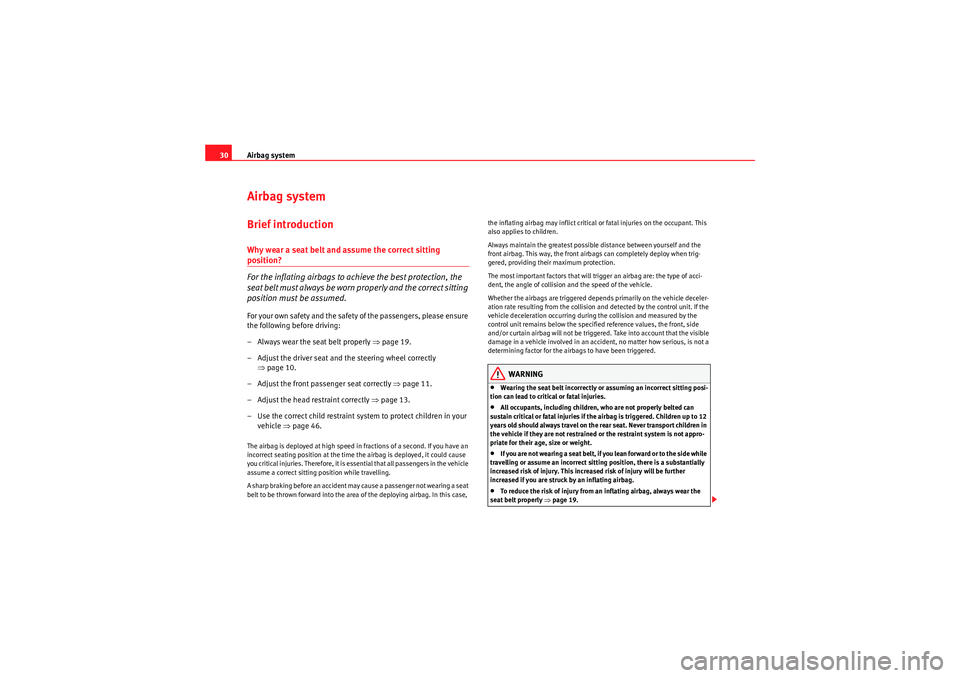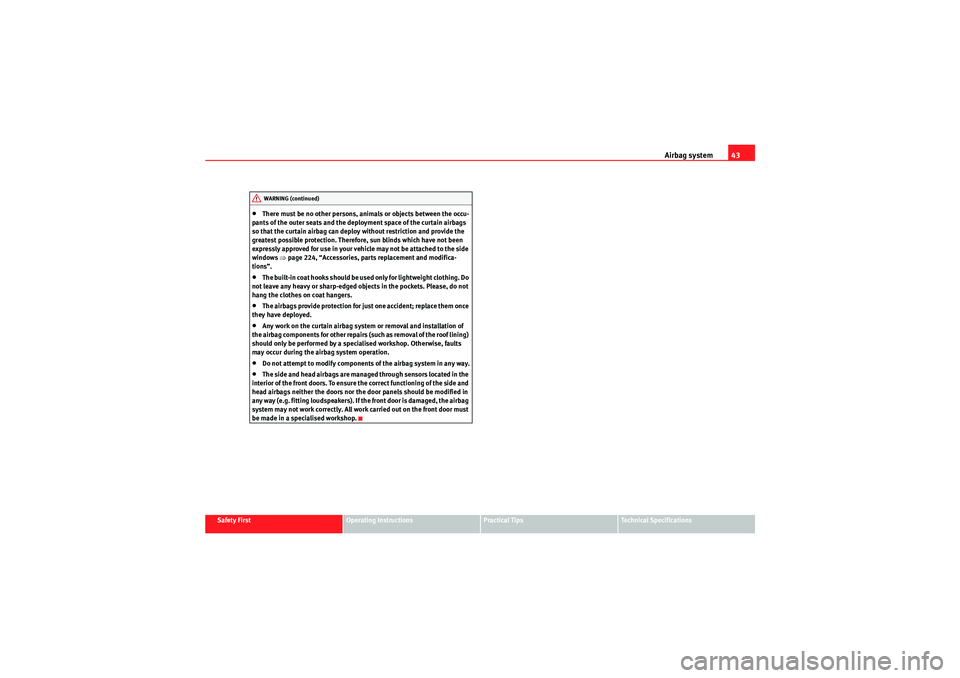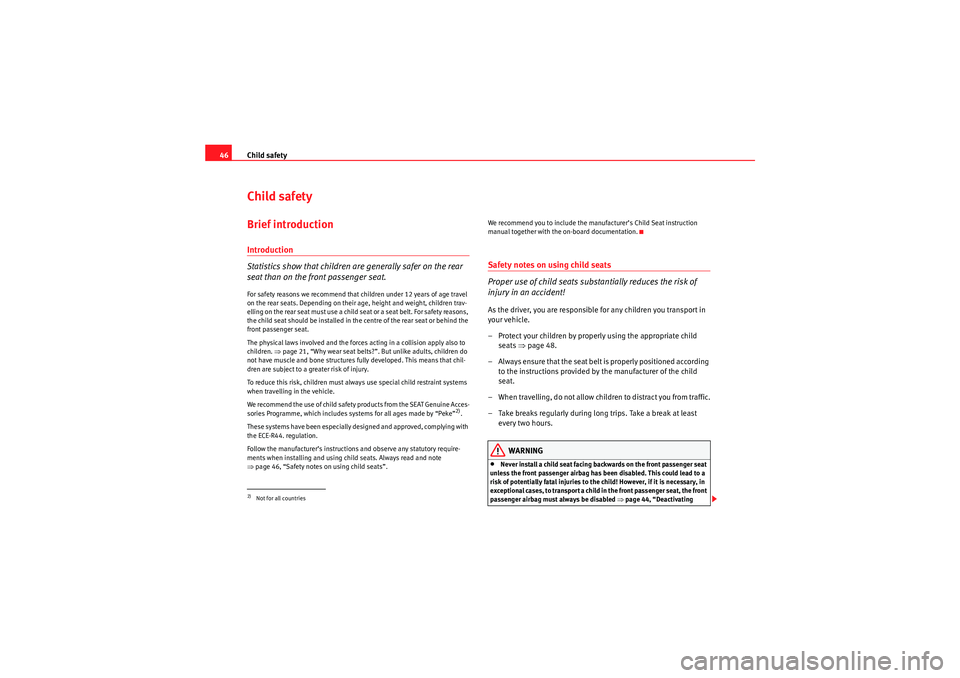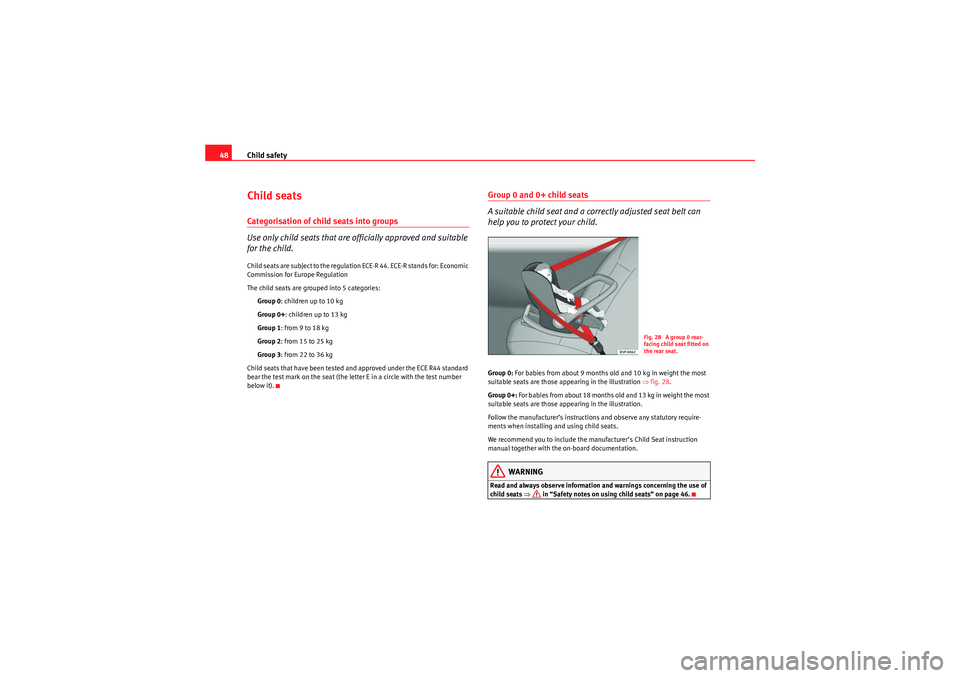2011 Seat Altea XL weight
[x] Cancel search: weightPage 19 of 319

Safe driving17
Safety First
Operating Instructions
Practical Tips
Technical Specifications
•Never lay or fit floor mats or other floor coverings over the original floor
mats. This would reduce the pedal area and could obstruct the pedals. Risk
of accident.
Storing objectsLoading the luggage compartment
All luggage and other loose objects must be safely secured in
the luggage compartment.Unsecured objects which shift back and forth could impair the
driving safety or driving characteristics of the vehicle by shifting the
centre of gravity.
– Distribute the load evenly in the luggage compartment.
– Place heavy objects as far forward as possible in the luggage compartment.
–Place the heavy objects first.
– Secure heavy objects to the fitted fastening rings*.
WARNING
•Loose luggage and other objects in the luggage compartment could
cause serious injuries.•Always stow objects in the luggag e compartment and secure them on
the fastening rings.•Use suitable straps to secure heavy objects.•During sudden manoeuvres or accidents, loose objects can be thrown
forward, injuring vehicle occupants or passers-by. This increased risk of
injury will be further increased if a loose object is struck by an inflating
airbag. If this happens, objects can be transformed into “missiles”. Risk of
fatal injury.•Please note that the centre of gravity may shift when transporting
heavy objects; this may affect the vehicle’s handling and lead to an acci-
dent. Therefore, it is essential to adjust your speed and driving style
accordingly, to avoid accidents.•Never exceed the allowed axle weights or allowed maximum weight. If
the allowed axle load or the allowed total weight is exceeded, the driving
characteristics of the vehicle may change, leading to accidents, injuries
and damage to the vehicle.•Never leave your vehicle unattended, especially when the tailgate is
open. Children could climb into the luggage compartment, closing the door
behind them; they will be trapped and run the risk of death.•Never allow children to play in or around the vehicle. Close and lock all
the doors and tailgate when you leave the vehicle. Before you lock the
vehicle, make sure that there are no adults or children in the vehicle.•Never transport passengers in the luggage compartment. All passen-
gers must have their seat belt fastened ⇒page 19.
WARNING (continued)
AlteaXL_EN.book Seite 17 Donnerstag, 9. September 2010 12:13 12
Page 22 of 319

Seat belts
20
– Protect children by using a child seat according to the child’s height and weight.After the ignition has been switched on, the warning lamp on the instru-
ment panel lights up
1) if the driver has not fastened his/her seat belt, and an
acoustic signal is heard if the vehicle is driven at more than 30 km/h.
The warning lamp* is switched off if the driver seat belt is fastened while
the ignition is switched on.
1)Depending on the model version.
AlteaXL_EN.book Seite 20 Donnerstag, 9. September 2010 12:13 12
Page 23 of 319

Seat belts21
Safety First
Operating Instructions
Practical Tips
Technical Specifications
Why wear seat belts?Physical principles of frontal collisions
In the event of a frontal collision, a large amount of kinetic
energy must be absorbed.
It is easy to explain how the laws of physics work in the case of a head-on
collision: When a vehicle starts moving ⇒fig. 7 , a certain amount of energy
known as kinetic energy is produced in the vehicle and its occupants.
The amount of kinetic energy depends on the speed of the vehicle and the
weight of the vehicle and its passengers. The higher the speed and the
greater the weight, the more energy there is to be released in an accident.
The most significant factor, however, is the speed of the vehicle. If the speed
doubles from 25 km/h to 50 km/h, for example, the kinetic energy is multi-
plied by four.
Because the passengers in our example are not restrained by seat belts, in
the case of a head-on collision all of their kinetic energy has to be absorbed
at the point of impact ⇒fig. 8.
Even at speeds of 30 km/h to 50 km/h, the forces acting on bodies in a colli-
sion can easily exceed one tonne (1000 kg). At greater speed these forces are
even higher.
Passengers not wearing seat belts are not “attached” to the vehicle. In a
head-on collision, they will move forward at the same speed their vehicle was
Fig. 7 Vehicle about to hit
a wall: the occupants are
not wearing seat belts
Fig. 8 The vehicle hits
the wall: the occupants
are not wearing seat belts
AlteaXL_EN.book Seite 21 Donnerstag, 9. September 2010 12:13 12
Page 32 of 319

Airbag system
30Airbag systemBrief introductionWhy wear a seat belt and assume the correct sitting position?
For the inflating airbags to achieve the best protection, the
seat belt must always be worn properly and the correct sitting
position must be assumed.For your own safety and the safety of the passengers, please ensure
the following before driving:
– Always wear the seat belt properly ⇒page 19.
– Adjust the driver seat and the steering wheel correctly ⇒page 10.
– Adjust the front passenger seat correctly ⇒page 11.
– Adjust the head restraint correctly ⇒page 13.
– Use the correct child restraint system to protect children in your vehicle ⇒page 46.The airbag is deployed at high speed in fractions of a second. If you have an
incorrect seating position at the time the airbag is deployed, it could cause
you critical injuries. Therefore, it is essential that all passengers in the vehicle
assume a correct sitting position while travelling.
A sharp braking before an accident may cause a passenger not wearing a seat
belt to be thrown forward into the area of the deploying airbag. In this case, the inflating airbag may inflict critical or fatal injuries on the occupant. This
also applies to children.
Always maintain the greatest possible distance between yourself and the
front airbag. This way, the front airbags can completely deploy when trig-
gered, providing their maximum protection.
The most important factors that will trigger an airbag are: the type of acci-
dent, the angle of collision and the speed of the vehicle.
Whether the airbags are triggered depends primarily on the vehicle deceler-
ation rate resulting from the collision and detected by the control unit. If the
vehicle deceleration occurring during the collision and measured by the
control unit remains below the specified reference values, the front, side
and/or curtain airbag will not be triggered. Take into account that the visible
damage in a vehicle involved in an accident, no matter how serious, is not a
determining factor for the airbags to have been triggered.
WARNING
•Wearing the seat belt incorrectly or assuming an incorrect sitting posi-
tion can lead to critical or fatal injuries.•All occupants, including children, who are not properly belted can
sustain critical or fatal injuries if the airbag is triggered. Children up to 12
years old should always travel on the rear seat. Never transport children in
the vehicle if they are not restrained or the restraint system is not appro-
priate for their age, size or weight.•I f yo u are n o t w ea r i ng a s ea t b e l t , i f yo u l e an fo r w a rd o r t o t h e s id e w h il e
travelling or assume an incorrect sitting position, there is a substantially
increased risk of injury. This increased risk of injury will be further
increased if you are struck by an inflating airbag.•To reduce the risk of injury from an inflating airbag, always wear the
seat belt properly ⇒page 19.
AlteaXL_EN.book Seite 30 Donnerstag, 9. September 2010 12:13 12
Page 42 of 319

Airbag system
40Safety notes on the operation of the side airbag system
If airbags are used correctly, they can considerably reduce the
risk of injury in side impact collisions.
WARNING
•If you do not wear a seat belt, if you lean forward, or are not seated
correctly while the vehicle is in motion, you are at a greater risk of injury if
the side airbag system is triggered in an accident.•In order for the side airbags to provide their maximum protection, the
prescribed sitting position must always be maintained with seat belts
fastened while travelling.•Occupants of the outer seats must never carry any objects or pets in the
deployment space between them and the airbags, or allow children or
other passengers to travel in this position. It is also important not to attach
any accessories (such as cup holders) to the doors. This would impair the
protection offered by the side airbags.•The built-in coat hooks should be us ed only for lightweight clothing. Do
not leave any heavy or sharp-edged objects in the pockets.•Great forces, such as hard blows or kicks, must not be exer ted upon the
backrest bolster because the system may be damaged. In this case, the
side airbags would not be triggered.•Under no circumstances should protective covers be fitted over seats
with side airbags unless the covers have been approved for use in your
vehicle. Because the airbag is triggered from the side of the backrest, the
use of non-approved seat covers would obstruct the side airbag, seriously
reducing the airbag’s effectiveness ⇒page 224, “Accessories, parts
replacement and modifications”.•Any damage to the original seat upholstery or around the seams of the
side airbag units must be repaired immediately by a specialised workshop.•The airbags provide protection for just one accident; replace them once
they have deployed.
•When children assume an incorrect sitting position, they expose them-
selves to an increased risk of injury in the event of an accident. This is
particularly the case if the child is travelling on the front passenger seat
and the airbag system is triggered in an accident; this could have critical
consequences including serious injury or death ⇒page 46, “Child safety”.•Any work on the side airbag system or removal and installation of the
airbag components for other repairs (such as removal of the front seat)
should only be performed by a specialised workshop. Otherwise, faults
may occur during the airbag system operation.•Do not attempt to modify components of the airbag system in any way.•The side and head airbags are managed through sensors located in the
interior of the front doors. To ensure the correct functioning of the side and
head airbags neither the doors nor the door panels should be modified in
any way (e.g. fitting loudspeakers). If the front door is damaged, the airbag
system may not work correctly. All work carried out on the front door must
be made in a specialised workshop.WARNING (continued)
AlteaXL_EN.book Seite 40 Donnerstag, 9. September 2010 12:13 12
Page 45 of 319

Airbag system43
Safety First
Operating Instructions
Practical Tips
Technical Specifications
•There must be no other persons, animals or objects between the occu-
pants of the outer seats and the deployment space of the curtain airbags
so that the curtain airbag can deploy without restriction and provide the
greatest possible protection. Therefore, sun blinds which have not been
expressly approved for use in your vehicle may not be attached to the side
windows ⇒page 224, “Accessories, parts replacement and modifica-
tions”.•The built-in coat hooks should be used only for lightweight clothing. Do
not leave any heavy or sharp-edged objects in the pockets. Please, do not
hang the clothes on coat hangers.•The airbags provide protection for just one accident; replace them once
they have deployed.•Any work on the curtain airbag system or removal and installation of
the airbag components for other repairs (such as removal of the roof lining)
should only be performed by a spec ialised workshop. Otherwise, faults
may occur during the airbag system operation.•Do not attempt to modify components of the airbag system in any way.•The side and head airbags are managed through sensors located in the
interior of the front doors. To ensure the correct functioning of the side and
head airbags neither the doors nor the door panels should be modified in
any way (e.g. fitting loudspeakers). If the front door is damaged, the airbag
system may not work correctly. All work carried out on the front door must
be made in a specialised workshop.WARNING (continued)
AlteaXL_EN.book Seite 43 Donnerstag, 9. September 2010 12:13 12
Page 48 of 319

Child safety
46Child safetyBrief introductionIntroduction
Statistics show that children are generally safer on the rear
seat than on the front passenger seat.For safety reasons we recommend that children under 12 years of age travel
on the rear seats. Depending on their age, height and weight, children trav-
elling on the rear seat must use a child seat or a seat belt. For safety reasons,
the child seat should be installed in the centre of the rear seat or behind the
front passenger seat.
The physical laws involved and the forces acting in a collision apply also to
children. ⇒page 21, “Why wear seat belts?”. But unlike adults, children do
not have muscle and bone structures fully developed. This means that chil-
dren are subject to a greater risk of injury.
To reduce this risk, children must always use special child restraint systems
when travelling in the vehicle.
We recommend the use of child safety products from the SEAT Genuine Acces-
sories Programme, which includes systems for all ages made by “Peke”
2).
These systems have been especially designed and approved, complying with
the ECE-R44. regulation.
Follow the manufacturer’s instructions and observe any statutory require-
ments when installing and using child seats. Always read and note
⇒ page 46, “Safety notes on using child seats”. We recommend you to include the manufacturer’s Child Seat instruction
manual together with the on-board documentation.
Safety notes on using child seats
Proper use of child seats substantially reduces the risk of
injury in an accident!As the driver, you are responsible for any children you transport in
your vehicle.
– Protect your children by properly using the appropriate child
seats ⇒page 48.
– Always ensure that the seat belt is properly positioned according to the instructions provided by the manufacturer of the child
seat.
– When travelling, do not allow children to distract you from traffic.
– Take breaks regularly during long trips. Take a break at least
every two hours.
WARNING
•Never install a child seat facing backwards on the front passenger seat
unless the front passenger airbag has been disabled. This could lead to a
risk of potentially fatal injuries to the child! However, if it is necessary, in
exceptional cases, to transport a child in the front passenger seat, the front
passenger airbag must always be disabled ⇒page 44, “Deactivating
2)Not for all countries
AlteaXL_EN.book Seite 46 Donnerstag, 9. September 2010 12:13 12
Page 50 of 319

Child safety
48Child seatsCategorisation of child seats into groups
Use only child seats that are officially approved and suitable
for the child.Child seats are subject to the regulation ECE-R 44. ECE-R stands for: Economic
Commission for Europe Regulation
The child seats are grouped into 5 categories:
Group 0 : children up to 10 kg
Group 0+ : children up to 13 kg
Group 1 : from 9 to 18 kg
Group 2 : from 15 to 25 kg
Group 3 : from 22 to 36 kg
Child seats that have been tested and approved under the ECE R44 standard
bear the test mark on the seat (the letter E in a circle with the test number
below it).
Group 0 and 0+ child seats
A suitable child seat and a correctly adjusted seat belt can
help you to protect your child.Group 0: For babies from about 9 months old and 10 kg in weight the most
suitable seats are those appearing in the illustration ⇒ fig. 28.
Group 0+: For babies from about 18 months old and 13 kg in weight the most
suitable seats are those appearing in the illustration.
Follow the manufacturer’s instructions and observe any statutory require-
ments when installing and using child seats.
We recommend you to include the manufacturer’s Child Seat instruction
manual together with the on-board documentation.
WARNING
Read and always observe information and warnings concerning the use of
child seats ⇒ in “Safety notes on using child seats” on page 46.
Fig. 28 A group 0 rear-
facing child seat fitted on
the rear seat.
AlteaXL_EN.book Seite 48 Donnerstag, 9. September 2010 12:13 12